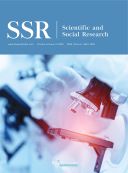Abstract
Considering theory-focused and relatively dull content of Theory of Missile Guidance and Control, and the low learning motivation and weak practical skills of the students, this paper describes the practice and experience of blended teaching reform in the course. A comprehensive analysis was done on real demands of students’ ability, the nature of the course and characteristics of content. The teaching idea of building a solid foundation, emphasizing on the operation of the of equipment, actual combat, and the development of equipment was applied. In order to improve the students’ abilities and their understanding of the subjects, a new blended teaching mode for the theoretical course of equipment was explored, so as to form an evolving cycle of “theoretical study, hands-on practical, and forming new abilities,” spark the students’ interest in learning, and cultivate new thoughts in autonomous learning and innovative practice. This teaching mode has been practiced for a few years and is shown to be effective in improving the ability of students and the quality of training for personnel of military technology. Therefore, it can be used as a reference for curriculum reform of courses involving equipment.
References
Ye J, Lei H, Li J, et al., 2017, Teaching Reform and Practice of Missile Guidance and Control Principle. Journal of Higher Education Research, 40(1): 98–102
Li M, Liu Y, 2018, Analysis on Basic Problems of Construction of Network Information System Based on “Military Network +”. Journal of Air Force Engineering University, 4(18): 36–39.
Cai J, Huang W, Tan W, et al., 2017, Discussion on Modular Blended Teaching Based on Online Teaching Platform. Applicaton-Oriented Higher Education Research, 2(1): 69¬–72.
Sun H, Zou H, Ji K, et al., 2013, From MOOC to MOORE — A Hybrid Course Teaching for Postgraduate Students in Military Academy. Journal of Higher Education Research, 36(4): 10-12.
Thorne K, 2003, Blended Learning: How to Integrate Online?Traditional Learning, Kogan, London 67.
Bersin J, 2004, The Blended Learning Book: Best Practices. Proven Methodologies and Lessons Learned Pfeiffer Publishing, California, 87-92.
Wang Z, 2017, Practice and Exploration of Blended Teaching Reform of Modern Chinese Curriculum for Art and Sports Majors, Research on Higher Education for Nationalities, 5(5): 87–92.
Zhang Y, Gao J, 2015, Research on the Application of Blended Teaching Mode in Universities. Chinese Journal of ICT in Education, 2015(18): 55–58.
Zhang Q, 2016, Training of Knowledge Application and Innovation Ability. Higher Education Research, 37(3): 62–67.
Liu Y, Yang L, Luo X, 2018, Comparative Study on Flipped Classroom and Traditional Classroom Teaching Mode. Journal of Higher Education Research, 41(1): 50–55.
Liu G, Li J, Liang H, 2017, Thinking and Countermeasures of College Teaching Innovation in the Era of “Internet +”. China Higher Education Research, 2017(2): 93–98.
Guo X, Yang L, Liu Y, et al., 2017, Comparative Study on Students’ Learning Engagement in Top Innovative Experimental College. Journal of Higher Education Research, 40(4): 91-95.
